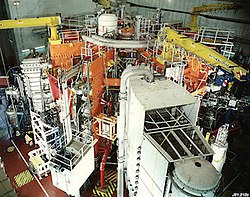
Back الحلقة الأوروبية المشتركة (جيت) Arabic Birləşdirilmiş Avropa Tokamakı Azerbaijani Joint European Torus BS Joint European Torus Catalan Joint European Torus Danish Joint European Torus German Joint European Torus Spanish Joint European Torus Finnish Joint European Torus French Comhthóras Eorpach Irish
| Joint European Torus | |
|---|---|
 JET in 1991 | |
| Device type | Tokamak |
| Location | Oxfordshire, UK |
| Affiliation | Culham Centre for Fusion Energy |
| Technical specifications | |
| Major radius | 2.96 m (9 ft 9 in) |
| Minor radius | 1.25 m (4 ft 1 in) |
| Plasma volume | 100 m3 |
| Magnetic field | 3.45 T (34,500 G) (toroidal) |
| Heating power | 38 MW |
| Plasma current | 3.2 MA (circular), 4.8 MA (D-shape) |
| History | |
| Year(s) of operation | 1983–2023 |
The Joint European Torus (JET) was a magnetically confined plasma physics experiment, located at Culham Centre for Fusion Energy in Oxfordshire, UK. Based on a tokamak design, the fusion research facility was a joint European project with the main purpose of opening the way to future nuclear fusion grid energy. At the time of its design JET was larger than any comparable machine.
JET was built with the hope of reaching scientific breakeven where the fusion energy gain factor Q =1.0.[1] It began operation in 1983 and spent most of the next decade increasing its performance in a lengthy series of experiments and upgrades. In 1991 the first experiments including tritium were made, making JET the first reactor in the world to run on the production fuel mix of 50–50 tritium and deuterium. It was also decided to add a divertor design to JET, which occurred between 1991 and 1993. Performance was significantly improved, and in 1997 JET set the record for the closest approach to scientific breakeven, reaching Q = 0.67 in 1997, producing 16 MW of fusion power while injecting 24 MW of thermal power to heat the fuel.[2]
Between 2009 and 2011, JET was shut down to rebuild many of its parts, to adopt concepts being used in the development of the ITER project in Saint-Paul-lès-Durance, in Provence, southern France.[3] In December 2020, a JET upgrade commenced using tritium, as part of its contribution to ITER.[4]
Immediately after the announcement of JET's closure at the IAEA conference in London, October 2023, the group "Scientists for JET" launched a petition to call for a review of the decision to close JET, with scientists fearing a research time gap and personnel loss between JET's closure and the start of ITER's operations.[5]
JET finished operations in December 2023, with decommissioning expected to last until 2040.[6]
- ^ Cite error: The named reference
eu28was invoked but never defined (see the help page). - ^ "History of Fusion". EUROfusion. 14 December 2017. Retrieved 10 February 2022.
- ^ Cite error: The named reference
milestoneswas invoked but never defined (see the help page). - ^ Gibney, Elizabeth (22 February 2021). "Fuel for world's largest fusion reactor ITER is set for test run". Nature. 591 (7848): 15–16. Bibcode:2021Natur.591...15G. doi:10.1038/d41586-021-00408-1. PMID 33619399.
- ^ Cite error: The named reference
PW_2023-11-01was invoked but never defined (see the help page). - ^ Cite error: The named reference
endwas invoked but never defined (see the help page).